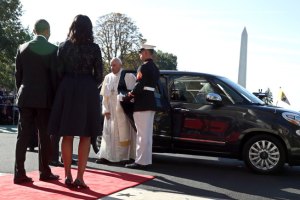At about nine-thirty on Wednesday morning, President Obama and his wife, Michelle, were standing at the South Portico of the White House waiting for their guest to arrive.
A big, black Secret Service S.U.V. pulled up, one of the type favoured by entertainment moguls and Manhattan limousine services, which weigh more than five thousand pounds and get about seven or eight miles to the gallon, on a good day.
Behind the huge gas guzzler, there was a little black Fiat 500L, the same car had ferried Pope Francis into town from Joint Base Andrews on Tuesday afternoon. Apart from the fact that it bore the license plate SCV 1, denoting it as the first vehicle of the Vatican City (“Status Civitatis Vaticanae”), it looked like any other 500L—a 1.4-litre, somewhat elongated version of the iconic Fiat 500, which gets about thirty-five miles to the gallon and costs around twenty thousand dollars. A Marine sentry held open the rear door on the passenger side, and the seventy-eight-year-old Pope climbed out to greet the President.
He’d been in the United States, which accounts for about a fifth of the world’s total oil consumption, for only about eighteen hours, and up to that point hadn’t said a word in public. Already, however, he had delivered a message.
That’s how this Pope often operates—through symbolism and gestures that convey his intentions in ways that words never could. As the theological leader of the faithful, his primary job is to define and redefine Catholic teaching for the twenty-first century, which, like his predecessors, he does partly by issuing written exhortations and encyclicals. In November, 2013, just more than eight months after succeeding Pope Benedict XVI, he issued a two-hundred-and-twenty-page challenge to global capitalism, wherein he said, “Just as the commandment ‘Thou shalt not kill’ sets a clear limit in order to safeguard the value of human life, today we also have to say ‘thou shalt not’ to an economy of exclusion and inequality.” (Rush Limbaugh dismissed the document as “pure Marxism.”) In June of this year, the Pope released a lengthy encyclical on climate change, parts of which read as if they had been written by Al Gore and the editors of The Nation. “The earth, our home, is beginning to look more and more like an immense pile of filth,” the encyclical said. It criticized our throwaway consumer culture, called for the world to undergo an “ecological conversion,” and demanded binding steps to limit carbon emissions, as well as global efforts to save the oceans and other threatened natural environments.
For good reason, these tracts have drawn a great deal of attention from scholars, commentators, and politicians—some of it supportive, some of it critical. Indeed, Pope Francis’s visit to the United States is all the more fascinating because it is taking place during a Presidential campaign, and much of what he has said on the subject of economics and the environment runs directly counter to the doctrines of the modern Republican Party. On other subjects, however, such as abortion and gay marriage, he has retained teachings that many Democrats finds odious.
But that is mere partisan politics. What has lifted Pope Francis above the political fray and reinvigorated his office in a way that could barely have been imagined under Pope Benedict, is his peerless ability to convey to ordinary people of all religions and political views his version of Catholicism—a version based largely on the life and teachings of Saint Francis of Assisi, the founder of the Franciscan Order. From choosing to live in a modest guest house, rather than the Apostolic Palace, to washing the feet of a young Muslim prisoner, to inviting dozens of homeless people to tour the Sistine Chapel, Pope Francis has lifted up the papacy by puncturing its grandeur, infusing it with humanity, and, where necessary, cleverly exploiting the power of imagery.
That’s where the Fiat 500L comes in. Back in July, 2013, Francis instructed Catholic priests to drive modest vehicles. ”It hurts me when I see a priest or nun with the latest-model car,” he said. ”You can’t do this. A car is necessary to do a lot of work, but, please, choose a more humble one. If you like the fancy one, just think about how many children are dying of hunger in the world.” The same month, he was spotted arriving at a papal summer house in a five-year-old Ford Focus. On previous foreign trips, too, he has largely foregone limousines or specially constructed security vehicles. When he returned to Latin America for the first time since being elevated, he was driven around Rio de Janeiro in a silver Fiat Idea, a model that is popular with middle-class Brazilians. (It has become even more popular since his visit.)
Now, to the evident astonishment of various television announcers—and, doubtless, the dismay of the Secret Service—the Pope is zigging around the U.S. capital in a Fiat 500L. Don’t think the world hasn’t noticed.
Article by John Cassidy “The New Yorker”


